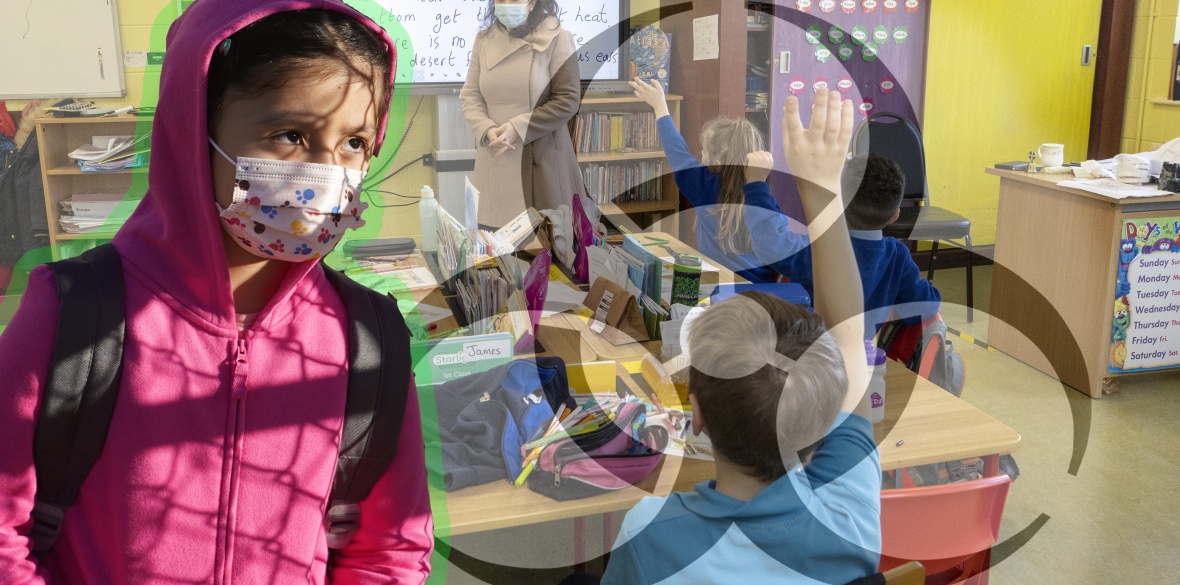This is the last article you can read this month
You can read more article this month
You can read more articles this month
Sorry your limit is up for this month
Reset on:
Please help support the Morning Star by subscribing here
ON March 8, in just under a week’s time, all schools in England can re-open and around 10 million children will return to school. Many parents and teachers are understandably worried about the effect that this will have on coronavirus transmission. The thousands of deaths from Covid-19 in the first few months of 2021 are a painful reminder of what unmitigated transmission can result in.
Nearly a year on from the first nationwide lockdown in Britain, what have we learned about infection in children and the potential for transmission in schools?
Thankfully, one pattern that has been repeated across the world is that children are far less likely to experience severe disease. While they may still be infected, they make up a tiny proportion of hospital admissions and deaths due to Covid-19.
Although children experience a less severe period of initial clinical disease, it is still an open question how much they experience ongoing symptoms for months after initial infection — the phenomenon we are just starting to understand as “long covid.”
If children can still transmit the virus, the question then turns to whether school attendance might act as a way for the disease to spread between households that are otherwise not in contact.
The most direct evidence available is from studies that have taken place in schools in countries such as Australia, Norway, and Italy. These studies follow the contacts (ie other students and teachers) of coronavirus infections that occur in children attending a school and test them to see how many subsequent infections have occurred.
They generally find that the proportion of contacts of school children that become infected is much lower than we find for other types of contact between people. Studies on transmission within households have typically found that an infected person infects around 10-20 per cent of their household contacts. In comparison, while precise estimates vary between studies, infected school children seem to infect under 2 per cent of their contacts.
This is a slightly unfair comparison. The contact you make with people in your household is much longer and closer than in schools. However, it does help to put in context the level of transmission within schools.
With that said, it is important to consider carefully what these school studies are telling us — and what they are not telling us. Since, by definition, they happen in schools where cases are being detected and contacts are being immediately isolated and tested, they tell us that transmission in schools is low with these procedures. But they don’t tell us what would happen if these procedures were not in place or not working properly.
To work out what effect school openings are having on transmission in the real world, outside of the well-run school studies, we have to turn to a different approach with its own limitations: trying to link changes in transmission (as measured by cases, hospital admissions, or deaths) to school openings.
Here, we immediately hit a stumbling block. Often coronavirus policy changes have happened in quick succession or even simultaneously. It’s a very thorny problem to try and disentangle whether a drop in cases is due to, for instance, schools opening three weeks ago or people returning to work one week ago.
Researchers have tried to step around this problem by collating data from many countries. Using information on what interventions were implemented when and how the country-level epidemic changed as a result, from this they can use statistical models to try and disentangle the effect of separate interventions.
This unfortunately faces another issue. Interventions differ in the details of their implementation between countries, as well as how effectively they are implemented, and how well the rules are adhered to.
Is it reasonable to expect a similar effect of “school openings” on transmission in all countries around the world, even accounting for other variables such as the demographics of the population or the local climate, if “school openings” can be very different?
Indeed, some of these studies find that closing schools is the single most effective intervention measure, whereas others find a much smaller effect. This is likely due to different ways of defining school closures (and other interventions) between different research groups.
A third strand of evidence, alongside the school studies and statistical models, is using our experience in Britain of how school openings and closures have changed our own epidemic. But here we have to be wary of over-interpreting links between the government’s pandemic policy and subsequent events, since it is impossible to test alternative theories.
For instance, we can never know with certainty what would have happened if we had locked down earlier in 2020. We can only use models to try and approximate the impact of lockdown and explore this scenario. Nevertheless, trying to understand changes in the British outbreak as a result of changes in British pandemic policy is not a worthless task.
One piece of evidence that arises from this pandemic detective work which seems reasonably robust is that the reproduction number (the average number of secondary infections for each new case) was increasing across Britain in the second half of November. This was despite a national lockdown at that point.
The reproduction number didn’t begin to decrease again until near the end of December, when schools and workplaces (where people could not work from home) closed for the Christmas holidays.
For questions such as Covid-19 transmission in schools, where we can only combine different streams of evidence, each with their own limitations, it is important to keep debates grounded in practical questions about what we can do despite some level of uncertainty.
While there is a lot of scientific debate on the topic, it is unlikely that anyone researching transmission in schools would argue that there is none. Opening schools will therefore cause an increase in transmission, but the magnitude of the increase is hard to predict because it seems like it will rely on how well schools are able to implement transmission reduction policies.
The potential increase in transmission due to school openings also needs to be considered in light of the changing field of play – many of the most clinically vulnerable people have been vaccinated – as well as balanced against the harms to children caused by school closures.
Given that the available evidence suggests that transmission within schools can be minimised with the correct policies, but the precise impact on transmission from opening schools is unknown, the National Education Union are right to call for a cautious reopening. The government must give material support for schools to implement adequate classroom ventilation, as well as provide clarification on specific safety measures.










